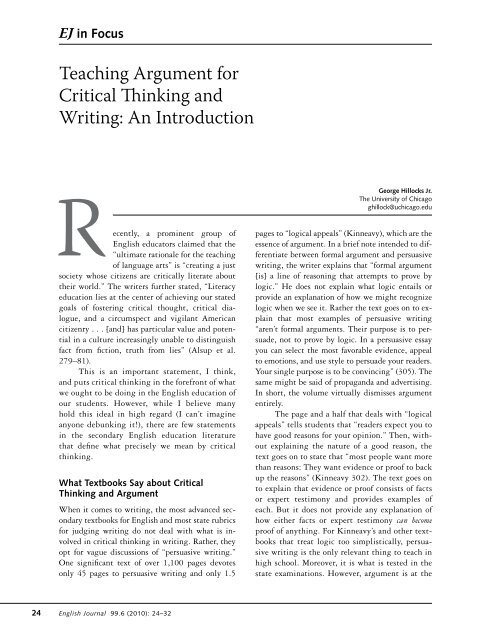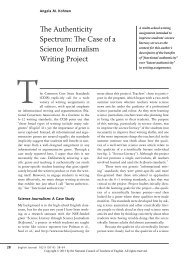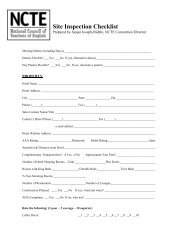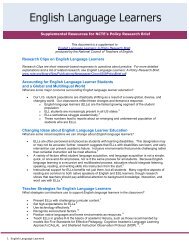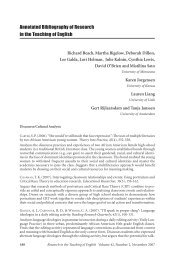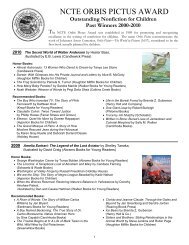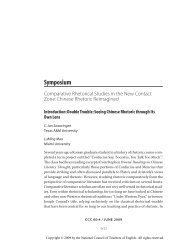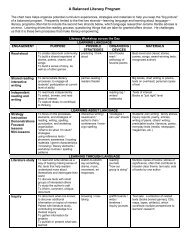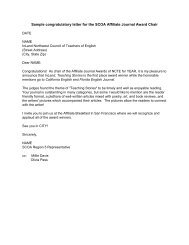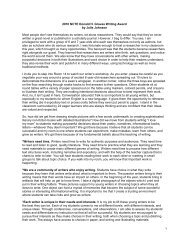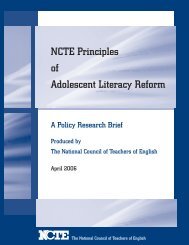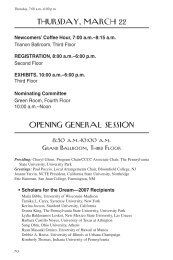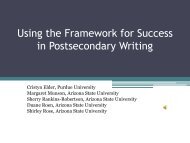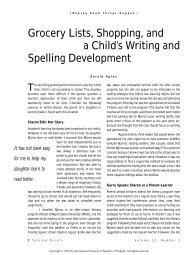Teaching Argument for Critical Thinking and Writing: An Introduction
Teaching Argument for Critical Thinking and Writing: An Introduction
Teaching Argument for Critical Thinking and Writing: An Introduction
Create successful ePaper yourself
Turn your PDF publications into a flip-book with our unique Google optimized e-Paper software.
EJ in Focus<br />
<strong>Teaching</strong> <strong>Argument</strong> <strong>for</strong><br />
<strong>Critical</strong> <strong>Thinking</strong> <strong>and</strong><br />
<strong>Writing</strong>: <strong>An</strong> <strong>Introduction</strong><br />
Recently, a prominent group of<br />
English educators claimed that the<br />
“ultimate rationale <strong>for</strong> the teaching<br />
of language arts” is “creating a just<br />
society whose citizens are critically literate about<br />
their world.” The writers further stated, “Literacy<br />
education lies at the center of achieving our stated<br />
goals of fostering critical thought, critical dialogue,<br />
<strong>and</strong> a circumspect <strong>and</strong> vigilant American<br />
citizenry . . . [<strong>and</strong>] has particular value <strong>and</strong> potential<br />
in a culture increasingly unable to distinguish<br />
fact from fiction, truth from lies” (Alsup et al.<br />
279–81).<br />
This is an important statement, I think,<br />
<strong>and</strong> puts critical thinking in the <strong>for</strong>efront of what<br />
we ought to be doing in the English education of<br />
our students. However, while I believe many<br />
hold this ideal in high regard (I can’t imagine<br />
anyone debunking it!), there are few statements<br />
in the secondary English education literature<br />
that define what precisely we mean by critical<br />
thinking.<br />
What Textbooks Say about <strong>Critical</strong><br />
<strong>Thinking</strong> <strong>and</strong> <strong>Argument</strong><br />
When it comes to writing, the most advanced secondary<br />
textbooks <strong>for</strong> English <strong>and</strong> most state rubrics<br />
<strong>for</strong> judging writing do not deal with what is involved<br />
in critical thinking in writing. Rather, they<br />
opt <strong>for</strong> vague discussions of “persuasive writing.”<br />
One significant text of over 1,100 pages devotes<br />
only 45 pages to persuasive writing <strong>and</strong> only 1.5<br />
George Hillocks Jr.<br />
The University of Chicago<br />
ghillock@uchicago.edu<br />
pages to “logical appeals” (Kinneavy), which are the<br />
essence of argument. In a brief note intended to differentiate<br />
between <strong>for</strong>mal argument <strong>and</strong> persuasive<br />
writing, the writer explains that “<strong>for</strong>mal argument<br />
[is] a line of reasoning that attempts to prove by<br />
logic.” He does not explain what logic entails or<br />
provide an explanation of how we might recognize<br />
logic when we see it. Rather the text goes on to explain<br />
that most examples of persuasive writing<br />
“aren’t <strong>for</strong>mal arguments. Their purpose is to persuade,<br />
not to prove by logic. In a persuasive essay<br />
you can select the most favorable evidence, appeal<br />
to emotions, <strong>and</strong> use style to persuade your readers.<br />
Your single purpose is to be convincing” (305). The<br />
same might be said of propag<strong>and</strong>a <strong>and</strong> advertising.<br />
In short, the volume virtually dismisses argument<br />
entirely.<br />
The page <strong>and</strong> a half that deals with “logical<br />
appeals” tells students that “readers expect you to<br />
have good reasons <strong>for</strong> your opinion.” Then, without<br />
explaining the nature of a good reason, the<br />
text goes on to state that “most people want more<br />
than reasons: They want evidence or proof to back<br />
up the reasons” (Kinneavy 302). The text goes on<br />
to explain that evidence or proof consists of facts<br />
or expert testimony <strong>and</strong> provides examples of<br />
each. But it does not provide any explanation of<br />
how either facts or expert testimony can become<br />
proof of anything. For Kinneavy’s <strong>and</strong> other textbooks<br />
that treat logic too simplistically, persuasive<br />
writing is the only relevant thing to teach in<br />
high school. Moreover, it is what is tested in the<br />
state examinations. However, argument is at the<br />
24 English Journal 99.6 (2010): 24–32
George Hillocks Jr.<br />
heart of critical thinking <strong>and</strong> academic discourse,<br />
the kind of writing students need to know <strong>for</strong><br />
success in college.<br />
What Students Need to Know<br />
<strong>for</strong> Success in College<br />
Those of us who know the needs of college writers<br />
<strong>and</strong> who are familiar with the new ACT <strong>and</strong> SAT<br />
writing samples know that persuasive writing<br />
will not suffice. For college <strong>and</strong> career one needs<br />
to know how to make an effective case, to make a<br />
good argument. Gerald Graff was recently cited<br />
in Education Week as giving the following advice<br />
to college students: “Recognize that knowing a<br />
lot of stuff won’t do you much good,” he wrote,<br />
“unless you can do something with what you<br />
know by turning it into an argument” (qtd. in<br />
Viadaro).<br />
In 2009, the National Governor’s Association<br />
Center <strong>for</strong> Best Practices <strong>and</strong> the Council of Chief<br />
State School Officers put a document on the Internet<br />
entitled College <strong>and</strong> Career Ready: St<strong>and</strong>ards <strong>for</strong><br />
Reading, <strong>Writing</strong>, <strong>and</strong> Communication. It says this of<br />
writing argument:<br />
The ability to frame <strong>and</strong> defend an argument is<br />
particularly important to students’ readiness <strong>for</strong><br />
college <strong>and</strong> careers. The goal of making an argument<br />
is to convince an audience of the rightness<br />
of the claims being made using logical reasoning<br />
<strong>and</strong> relevant evidence. In some cases, a student<br />
will make an argument to gain access to college<br />
or to a job, laying out their qualifications or<br />
experience. In college, a student might defend an<br />
interpretation of a work of literature or of history<br />
<strong>and</strong>, in the workplace, an employee might write<br />
to recommend a course of action. Students must<br />
frame the debate over a claim, presenting the evidence<br />
<strong>for</strong> the argument <strong>and</strong> acknowledging <strong>and</strong><br />
addressing its limitations. This approach allows<br />
readers to test the veracity of the claims being<br />
made <strong>and</strong> the reasoning being offered in their<br />
defense. (2B)<br />
Calls <strong>for</strong> increased attention to logical thinking<br />
<strong>and</strong> argumentation should be heard. Here I<br />
provide in<strong>for</strong>mation <strong>and</strong> an example from a real<br />
classroom <strong>for</strong> teaching logical argument in a complex<br />
<strong>and</strong> effective manner.<br />
What Kind of Logic Can We Teach?<br />
In this day of postmodernism <strong>and</strong> the widespread<br />
notion among literacy scholars <strong>and</strong> certain philosophers<br />
that we cannot know anything with certainty,<br />
the question is this: What can count as logic<br />
in arguments? If argument dem<strong>and</strong>s logic, <strong>and</strong> if<br />
we are going to teach it, then we must have an<br />
answer.<br />
The kind of logic taught in schools since the<br />
time of Aristotle <strong>and</strong> through the early 20th century<br />
centers in the syllogism, thought to be the<br />
most important, if not the only, path to truth (see<br />
Aristotle, Prior). The syllogism derives a conclusion<br />
from a set of statements called premises, which are<br />
thought to be true <strong>and</strong> which have a common or<br />
middle term in each. For example,<br />
Major premise:<br />
Minor premise:<br />
Conclusion:<br />
All men are mortal.<br />
Socrates is a man.<br />
There<strong>for</strong>e, Socrates is<br />
mortal.<br />
In most disciplines (with the exceptions of<br />
mathematics <strong>and</strong> sometimes physics) <strong>and</strong> in most<br />
everyday problems <strong>and</strong> disputes, we do not have<br />
premises that we know to be absolutely true. We<br />
have to deal with statements that may be true or<br />
that we believe are probably true—but not absolutely<br />
true.<br />
Aristotle, the chief inventor of the syllogism<br />
whose works were used throughout the Middle<br />
Ages <strong>and</strong> the Renaissance as the Bible of syllogistic<br />
thinking, recognized that the syllogism was<br />
not appropriate <strong>for</strong> the problems that he saw being<br />
debated in the senate <strong>and</strong> elsewhere. These were<br />
arguments of probability, arguments that were not<br />
amenable to syllogistic reasoning. His response to<br />
that problem was his Rhetoric, long recognized as<br />
one of the most important texts in the field of<br />
rhetoric. It deals with arguments of probability of<br />
three kinds: <strong>for</strong>ensic, epideictic, <strong>and</strong> deliberative,<br />
or what I like to call arguments of fact, judgment,<br />
<strong>and</strong> policy.<br />
In the past two or three decades, colleges <strong>and</strong><br />
universities have turned to a newer treatment of arguments<br />
of probability, that by Stephen E. Toulmin<br />
in The Uses of <strong>Argument</strong>. Several popular college<br />
English Journal<br />
25
<strong>Teaching</strong> <strong>Argument</strong> <strong>for</strong> <strong>Critical</strong> <strong>Thinking</strong> <strong>and</strong> <strong>Writing</strong>: <strong>An</strong> <strong>Introduction</strong><br />
writing texts are based on the theories of Toulmin<br />
<strong>and</strong> devote considerable space to the explication<br />
<strong>and</strong> teaching of the methods involved (e.g., Luns<strong>for</strong>d<br />
<strong>and</strong> Ruskiewiscz; Ramage, Bean, <strong>and</strong> Johnson; Williams<br />
<strong>and</strong> Colomb).<br />
Toulmin’s basic conception of argument includes<br />
several elements: a claim based on evidence<br />
of some sort, with a warrant that explains how the<br />
evidence supports the claim, backing supporting<br />
the warrants, qualifications, <strong>and</strong> rebuttals or<br />
counterarguments that refute competing claims.<br />
Figure 1 provides a representation of these elements<br />
<strong>and</strong> their relationships.<br />
Although many teachers begin to teach some<br />
version of argument with the writing of a thesis<br />
statement, in reality, good argument begins with<br />
looking at the data that are likely to become the<br />
evidence in an argument <strong>and</strong> that give rise to a<br />
thesis statement or major claim. A thesis statement<br />
arises from a question, which in turn rises<br />
from the examination of in<strong>for</strong>mation or data of<br />
Figure 1. A Schematic Representation<br />
of Toulmin’s Theory of <strong>Argument</strong><br />
Evidence<br />
Warrant<br />
Backing<br />
Rules, laws, agreed-on<br />
common sense, scientific<br />
findings, <strong>and</strong>, particularly<br />
in arguments of judgment,<br />
definitions that are reached<br />
through Socratic <strong>and</strong><br />
Aristotelian reasoning as<br />
seen in US Supreme Court<br />
discussions<br />
Qualification<br />
Claim<br />
Rebuttals<br />
G. Hillocks. Oct. 2009. Based on Stephen Toulmin. The Uses<br />
of <strong>Argument</strong>. Cambridge: Cambridge UP, 1958.<br />
some sort. This year, I had an opportunity to examine<br />
a set of lesson plans that began the year<br />
with the writing of thesis statements. There was<br />
no mention of data of any kind. Apparently, students<br />
were supposed to find problems somewhere<br />
<strong>and</strong> make some claim about them. However, without<br />
analysis of any data (verbal <strong>and</strong> nonverbal<br />
texts, materials, surveys <strong>and</strong> samples), any thesis<br />
is likely to be no more than a preconception or assumption<br />
or clichéd popular belief that is unwarranted<br />
<strong>and</strong>, at worst, totally indefensible. For that<br />
reason, my students <strong>and</strong> I have approached the<br />
teaching of argument from the examination of<br />
data as a first step. We have tried to find data sets<br />
that require some interpretation <strong>and</strong> give rise to<br />
questions. When the data are curious, do not fit<br />
preconceptions, they give rise to questions <strong>and</strong><br />
genuine thinking. Attempts to answer these questions<br />
become hypotheses, possible future thesis<br />
statements that we may eventually write about<br />
after further investigation. That is to say, the process<br />
of working through an argument is the process of inquiry.<br />
At its beginning is the examination of data,<br />
not the invention of a thesis statement in a<br />
vacuum.<br />
Once we have examined data to produce a<br />
question <strong>and</strong> have reexamined the data to try to<br />
produce an answer to the question, we may have a<br />
claim or thesis worthy of arguing. Occasionally,<br />
our readers or listeners are willing to accept data as<br />
appropriate support <strong>for</strong> our answers to these questions,<br />
but, more often, especially in serious arguments,<br />
they will want explanations of why the data<br />
we produce support the claims we make <strong>and</strong> are<br />
trying to demonstrate. This is the job of the<br />
warrant.<br />
Warrants<br />
Warrants may be simply commonsense rules that<br />
people accept as generally true, laws, scientific principles<br />
or studies, <strong>and</strong> thoughtfully argued definitions.<br />
In contemporary crime scene investigation<br />
programs on TV, considerable time is devoted to<br />
establishing warrants. Most viewers of such programs<br />
are likely to be fully aware, <strong>for</strong> example, that<br />
fingerprints at a crime scene may lead to an arrest of<br />
the person to whom those prints belong because<br />
any given person’s prints are unique, <strong>and</strong> there<strong>for</strong>e<br />
indicate the presence of that person at the scene.<br />
26 July 2010
George Hillocks Jr.<br />
Similarly, we also know that pistols <strong>and</strong> rifles leave<br />
distinctive markings on bullets fired from them.<br />
Thus, a bullet found in a victim or at a crime scene<br />
may become the evidence that links a gun owner to<br />
the shooting of the gun <strong>and</strong> the commission of the<br />
related crime. The prints <strong>and</strong> the markings on bullets<br />
are the evidence that indicate the identity of<br />
perpetrators by way of warrants concerning their<br />
uniqueness.<br />
Backing<br />
<strong>An</strong>yone familiar with these programs also knows<br />
that the warrants may be challenged. In Toulmin’s<br />
terms, the backing is the support <strong>for</strong> the warrants.<br />
In the case of fingerprints <strong>and</strong> ballistics, there have<br />
been many studies that can be cited in the support<br />
of the warrants as to the uniqueness of fingerprints<br />
<strong>and</strong> bullet markings. However, in the TV shows<br />
themselves, sometimes considerable time is devoted<br />
to developing the backing <strong>for</strong> warrants. One frequently<br />
visited kind of backing in one program has<br />
to do with the development of studies of the development<br />
of beetles in corpses as the backing <strong>for</strong> warrants<br />
<strong>for</strong> assertions or claims concerning the length<br />
of time a corpse has been dead. Sometimes we see<br />
the criminalist studying the development of beetles<br />
from larva to adult to establish a time-line <strong>for</strong> the<br />
development of the insect through its various<br />
stages. This study will be the backing <strong>for</strong> the warrant<br />
<strong>for</strong> claims about how long a corpse has been<br />
deceased.<br />
In more complex arguments of judgment <strong>and</strong><br />
policy, the most crucial arguments pertain to the<br />
warrants <strong>and</strong> their backing. Platonic dialogues<br />
often deal with the backing <strong>for</strong> warrants. For example,<br />
in the Euthyphro, Socrates questions Euthyphro<br />
concerning his claim that he is justified in<br />
prosecuting his father <strong>for</strong> the death of a slave. The<br />
U.S. Supreme Court’s discussions of cases are debates<br />
about the warrants used in lower court cases<br />
that have been appealed. In Scott v. Harris, <strong>for</strong> example,<br />
the argument concerns whether a police officer<br />
may use lethal <strong>for</strong>ce to stop a driver doing on<br />
average 90 mph on a two-lane road <strong>and</strong> crossing<br />
the double yellow line even in the face of oncoming<br />
traffic. Harris claimed that the officer’s ramming<br />
of his car was a violation of his Fourth<br />
Amendment right protecting him against unjust<br />
seizure.<br />
Qualifications <strong>and</strong> Counterarguments<br />
In addition, because these are arguments of probability,<br />
two other elements are necessary: qualifications<br />
<strong>and</strong> counterarguments. Simply because we are<br />
dealing with statements that cannot be demonstrated<br />
to be absolutely true, qualifications are necessary<br />
in stating both claims <strong>and</strong> warrants. For<br />
claims, I like to encourage the use of words such as<br />
probably, very likely, almost certainly, <strong>and</strong> so <strong>for</strong>th.<br />
Some instructors refer to these as hedge terms. But<br />
they are not.<br />
The idea that we are dealing with arguments<br />
of probability suggests that differing claims are<br />
likely to exist. For example, <strong>for</strong> over a hundred<br />
years, available evidence has shown that the teaching<br />
of traditional school grammar does not contribute<br />
to increasing the quality of student writing (see<br />
Braddock, Lloyd-Jones, <strong>and</strong> Schoer; Graham <strong>and</strong><br />
Perin; Hillocks, “What Works”). Despite what I regard<br />
as massive evidence, many teachers <strong>and</strong> writers<br />
continue to argue <strong>for</strong> the teaching of traditional<br />
school grammar, the teaching of the parts of speech,<br />
parts of sentences, <strong>and</strong> concepts of grammar such as<br />
gerunds, appositives, <strong>and</strong> introductory adverbial<br />
clauses through the exercises presented in grammar<br />
books such as Kinneavy’s. If I wished to make an<br />
argument as to the folly of teaching grammar again,<br />
I might have to make a counterargument to their<br />
position.<br />
<strong>Teaching</strong> the Basic Elements<br />
of <strong>Argument</strong> (<strong>Argument</strong>s of Fact):<br />
A Classroom Example<br />
All of this has been discursive <strong>and</strong> what I call presentational<br />
(Hillocks, “What Works”) <strong>and</strong> declarative<br />
(Hillocks, Ways of <strong>Thinking</strong>). Students at the<br />
high school level <strong>and</strong> even above are unlikely to<br />
learn anything from such a method. Perhaps they<br />
will learn the terms, but I am quite certain they will<br />
not learn to develop strong arguments on their own.<br />
To learn that, they will have to become engaged in a<br />
highly interesting activity that is both simple <strong>and</strong><br />
challenging, <strong>for</strong> which feedback is immediate <strong>and</strong><br />
clear, that allows <strong>for</strong> success <strong>and</strong> inspires further ef<strong>for</strong>t,<br />
what Mihaly Csikszentmihalyi calls the flow<br />
experience.<br />
For over 30 years, my students <strong>and</strong> I have<br />
been working on the development of such activities<br />
English Journal<br />
27
<strong>Teaching</strong> <strong>Argument</strong> <strong>for</strong> <strong>Critical</strong> <strong>Thinking</strong> <strong>and</strong> <strong>Writing</strong>: <strong>An</strong> <strong>Introduction</strong><br />
<strong>for</strong> teaching argument <strong>and</strong> other important aspects<br />
of English as well. We have often used the following<br />
problem to introduce <strong>for</strong>ensic argument to Chicago<br />
high school students. Recently, I used it with<br />
a class of 30 ninth graders, six of whom had been<br />
labeled as learning disabled. Of the 30, 21 were<br />
Latino/Latina, four were African American, <strong>and</strong><br />
four were white, one of whom had Polish as a first<br />
language, <strong>and</strong> one was Asian with M<strong>and</strong>arin as a<br />
first language. It was a new class <strong>for</strong> me, which I<br />
had borrowed <strong>for</strong> seven weeks to try lessons <strong>and</strong> to<br />
collect writing samples.<br />
For the first day of talk with the students, I<br />
distribute what might be called the crime scene<br />
picture (Treat). It is a line drawing of a woman<br />
dressed in a <strong>for</strong>mal gown looking down at a man<br />
lying at the foot of the stairs, face up, his right foot<br />
resting on the third step of the staircase, a glass<br />
held in his left h<strong>and</strong> between his <strong>for</strong>efinger <strong>and</strong><br />
thumb. He is nattily dressed in tuxedo trousers, a<br />
smoking jacket, a dress shirt, <strong>and</strong> a bow tie. His<br />
clothing is quite neat. Had he been coming down<br />
the stairs, the banister would have been on his left.<br />
The c<strong>and</strong>elabras <strong>and</strong> mirror opposite the banister<br />
are undisturbed.<br />
I say, “We are going to be the investigators<br />
who try to determine what really happened at this<br />
crime scene.”<br />
I read a passage entitled “Slip or Trip” to the<br />
students as they examine the picture. (I notice that<br />
it has immediately captured their interest. They are<br />
scrutinizing it.) The passage tells us that Queenie,<br />
the woman in the gown, had gone to the country<br />
club after a fight with her husb<strong>and</strong>, Arthur, the<br />
man on the floor. She left the club shortly be<strong>for</strong>e<br />
one in the morning <strong>and</strong> invited a few friends to follow<br />
her home <strong>and</strong> have one more drink. They got to<br />
the Volupides’ house about ten minutes after<br />
Queenie, who met them at the door <strong>and</strong> said,<br />
“Something terrible happened. Arthur slipped <strong>and</strong><br />
fell on the stairs. He was coming down <strong>for</strong> another<br />
drink—he still had the glass in his h<strong>and</strong>—<strong>and</strong> I<br />
think he’s dead. Oh, my God—what shall I do?”<br />
The autopsy concluded that Arthur had died from a<br />
wound on the head <strong>and</strong> confirmed the fact that he’d<br />
been drunk.<br />
I say, “I want you to assume that you are on<br />
the scene to try to determine what happened. Our<br />
first question should be, ‘Can we believe what<br />
Queenie says?’ Most of you have learned, from<br />
watching various crime shows, that witnesses are<br />
not always reliable. What do you think? Is what<br />
you see in the picture consistent with what<br />
Queenie says? If you have any ideas, raise your<br />
h<strong>and</strong>.”<br />
There is a rustling of paper <strong>and</strong> squeaking of<br />
chairs as students bend over their copies of the<br />
picture. I wait. I have the overhead on with a<br />
transparency divided in two columns. The left column<br />
is labeled Evidence <strong>and</strong> the right, Rule. Some<br />
of the kids are whispering to each other, but I can<br />
tell it is about the picture because they are pointing<br />
to it. After no more than 10 to 15 seconds,<br />
Marisol has her h<strong>and</strong> in the air. I wait <strong>for</strong> a few<br />
more seconds. Soon Jorge <strong>and</strong> William have their<br />
h<strong>and</strong>s in the air as well. Then Isobel, <strong>and</strong> Lucita. I<br />
call on Marisol.<br />
“He’s still got the glass in his h<strong>and</strong>. I mean, if<br />
you fell, you would drop the glass, wouldn’t you?”<br />
I say, “Well, I’m not sure. What do the rest of<br />
you think?”<br />
Jorge does not wait to be called on. “Yeah,<br />
you drop stuff when you fall, except, maybe like a<br />
football when you get tackled.”<br />
Dantonio responds, “Yeah, but that a special<br />
thing. You drop the ball, everybody hate you. But<br />
the glass ain’t important. You drop the glass to save<br />
you ass.” The class laughs. I decide to let it go.<br />
Dantonio is supposed to be learning disabled, <strong>and</strong> I<br />
am pleased to have him contribute. Besides, I had<br />
already laughed involuntarily. (It is interesting to<br />
note that this young man, through my seven weeks,<br />
is one of the strongest students in the class. So much<br />
<strong>for</strong> school labels.)<br />
Isobel responds to that, “It depends on what<br />
you’re carryin’. I was carryin’ my baby sister once,<br />
<strong>and</strong> I tripped, but I di’n’t drop her. I tried to keep<br />
her from hittin’ the floor.”<br />
Dantonio says, “That what I sayin’. It depend<br />
on how important what you carryin’.”<br />
“OK,” I say. “How many of you think that the<br />
fact that Arthur still has a glass in his h<strong>and</strong> is important<br />
evidence?” I pause to look around the room.<br />
Nearly all h<strong>and</strong>s are up. I write in the left-h<strong>and</strong> column,<br />
under Evidence, “Arthur still has a glass in his<br />
h<strong>and</strong>.”<br />
“Now,” I say, “let’s see why that is important.<br />
Can someone explain why that is important?”<br />
28 July 2010
George Hillocks Jr.<br />
Almost immediately, Marisol’s h<strong>and</strong> is up. I<br />
point to her. “It’s important because if you fall down<br />
stairs <strong>and</strong> die, you’re gonna drop the glass. That’s<br />
obvious.” Under Rule, I write Marisol’s response.<br />
“Do we only drop glasses?” I ask. “Or does it<br />
apply to other things?”<br />
Dantonio does not wait again. “If it be important,<br />
you hold on, like a football. But if it ain’t<br />
nothin’, you probably drop it to save you self.”<br />
“Does everyone agree with that?” I ask. Most<br />
heads are nodding in agreement. “Let’s see if we can<br />
make that into a general rule. We can work with<br />
what Marisol said earlier <strong>and</strong> with what Dantonio<br />
just said. Take a minute to think about how to say it<br />
<strong>and</strong> write down a version of the rule.” I look around<br />
the room. Some students are trying to write something.<br />
Some are looking puzzled. A few are staring<br />
off into space, perhaps thinking, perhaps not. I wait<br />
several more seconds. “Try to write something,” I<br />
say. Several students begin to write. I walk about the<br />
room encouraging everyone to write something. I<br />
tell Dantonio to use what he just said to the class. I<br />
suggest that Maria begin with the word when to<br />
write a sentence explaining what happens when people<br />
fall down the stairs. Most students are writing a<br />
sentence or two. But nearly all of them are using<br />
second person, just as they had in the preceding discussion.<br />
I will try to explain how to make the rule<br />
third person so that it is more general than what<br />
happens to a you. I call <strong>for</strong> volunteers. Barbara raises<br />
her h<strong>and</strong>. “When you fall down the stairs, you drop<br />
what you’re carrying unless it’s really important.”<br />
“Very good,” I say <strong>and</strong> write Barbara’s sentence<br />
on the overhead. I call <strong>for</strong> other sentences <strong>and</strong><br />
students read several aloud, all more or less like<br />
Barbara’s. I write another two on the overhead. “Let<br />
me summarize what we know so far. Arthur still<br />
has a glass in his h<strong>and</strong>. We know that when people<br />
fall down the stairs, they probably drop what they<br />
are carrying to save themselves. What can we conclude<br />
from that?” Students are silent. I wonder if<br />
they know what I mean by conclude. I try again.<br />
“What do you make of Queenie’s story now?”<br />
Marisol has her h<strong>and</strong> up along with about five<br />
other students. I call on Victoria. “I think she’s<br />
lying.”<br />
“What do the rest of you think?”<br />
Dantonio says, “Yeah, she lyin’—probably.”<br />
“Why did you add probably?”<br />
Thompson-McClellan Photography<br />
“’Cause we don’t know <strong>for</strong> sure. But it sure<br />
look like she lyin’.”<br />
I say to the class, “That’s a very important point.<br />
The arguments we will be talking about are all arguments<br />
of probability. That simply means that we can<br />
be only fairly certain of our claims. That is why we<br />
call such statements claims—because we are claiming<br />
they are true.” I am aware that this point will have to<br />
come up many times <strong>for</strong> it to be clear. But Dantonio<br />
has put the class on the road to underst<strong>and</strong>ing. I decide<br />
to go back to the statements of warrants.<br />
“Let’s look again at these sentences from Marisol,<br />
Gladys, <strong>and</strong> Roberto.” I point to the sentences<br />
on the overhead. “These sentences are important<br />
because they explain the evidence <strong>and</strong> show how it<br />
supports our claim that Queenie is probably lying.<br />
In writing them there are a couple of things I would<br />
like you to do. First, if I say you, to whom does that<br />
apply? About whom am I speaking?”<br />
Roscoe, an African American boy, raises his<br />
h<strong>and</strong>. “You talking to us.”<br />
“Right. Now does this general rule apply<br />
only to people in this room?” There is a chorus of<br />
“No.”<br />
“So, how can we make it more general?” I ask.<br />
My question is met with silence. I decide not to<br />
play guessing games, but just then, Marisol raises<br />
her h<strong>and</strong>. I nod to her.<br />
“You could say, like, um, like we already did,<br />
‘When people fall down stairs, they probably drop<br />
what they’re carrying if it’s not important.’”<br />
“Good,” I say. “That makes the statement a<br />
little bit more <strong>for</strong>mal <strong>and</strong> more generally applicable.<br />
Now I want to suggest another way to indicate<br />
English Journal<br />
29
<strong>Teaching</strong> <strong>Argument</strong> <strong>for</strong> <strong>Critical</strong> <strong>Thinking</strong> <strong>and</strong> <strong>Writing</strong>: <strong>An</strong> <strong>Introduction</strong><br />
that this is probably the case. What you have stated<br />
in that sentence is a general rule that most of us<br />
agree with. Right? So we can say that. ‘As a rule,<br />
when people fall down stairs, they drop what they<br />
are carrying to save themselves.’” I write that sentence<br />
on the overhead opposite “Arthur still has a<br />
glass in his h<strong>and</strong>.”<br />
“I would like us to refer to statements like this<br />
as rules or general rules.” I underline the label, Rule,<br />
of the right-h<strong>and</strong> column on the overhead. “Now,<br />
who can put this whole argument together?” Several<br />
h<strong>and</strong>s go up. Roberto looks as though he is going to<br />
fall out of his seat in his eagerness. I call on him.<br />
“Um, Arthur still has a glass in his h<strong>and</strong>. As a<br />
rule, when people fall down stairs, they drop what<br />
they are carrying to save themselves. So I think<br />
Queenie is probably lying about him falling down<br />
the stairs.” On a clean overhead transparency, I write<br />
what Roberto has said, each sentence on a separate<br />
line. “Good,” I say. “What we have here are four basic<br />
parts of a simple argument.” I label the sentences<br />
Evidence, Rule, <strong>and</strong> Claim; I underline Probably <strong>and</strong><br />
beneath the line I write Probably = Qualification.<br />
As we continue to discuss the picture, students<br />
note several other details <strong>and</strong> think through<br />
the warrants that make them evidence: The glass is<br />
in Arthur’s left h<strong>and</strong> (But when people come down<br />
the stairs drunk, they are likely to hold on to a banister,<br />
which would have been on his left); Arthur’s<br />
clothing is very neat (When people fall down the<br />
stairs, their clothes “get messed up”); the glass is<br />
still in his h<strong>and</strong>, even though he is dead (When<br />
people die, their muscles relax <strong>and</strong> anything they<br />
are holding will slip from their h<strong>and</strong>s); Arthur is<br />
lying face up (As a rule, when people fall down<br />
stairs, they are likely to l<strong>and</strong> on the chest, face<br />
down, not on their backs); the fixtures on the wall<br />
opposite the banister are undisturbed (When people<br />
are falling, they tend to reach out <strong>for</strong> anything<br />
to keep themselves steady); Arthur’s <strong>for</strong>efinger is<br />
inside the glass (Generally, when people intend to<br />
get another drink, they are unlikely to place their<br />
fingers in the glass they are using). Discussing these<br />
details <strong>and</strong> developing the warrants usually takes<br />
the remainder of the class period.<br />
Once we have completed these discussions,<br />
we turn to writing a report that will include the<br />
full argument. I begin by asking students, “If you<br />
were really an investigative team <strong>and</strong> if this were a<br />
real crime, to whom would you have to write a report?”<br />
Students suggest the boss, the Chief Inspector,<br />
the District Attorney, or the Chief of Police.<br />
We usually settle on the Chief of Police or the District<br />
Attorney. I ask, “What would we need to explain<br />
to that audience?” I make a list of their<br />
suggestions on the overhead. If they miss any of the<br />
following, I ask a direct question, e.g., “Should we<br />
explain when we arrived on the scene?” Here is<br />
what this class listed:<br />
When we arrived.<br />
What we found.<br />
What Queenie said.<br />
What the autopsy found.<br />
Does the evidence support what Queenie<br />
said?<br />
Our conclusion <strong>and</strong>/or recommendation.<br />
Explanation of evidence supporting our conclusion<br />
<strong>and</strong> recommendation.<br />
Next, I begin to write what students dictate<br />
on the overhead. Ordinarily, this involves asking a<br />
lot of questions to help students clarify their thinking<br />
<strong>and</strong> organize it. But once we have the outline<br />
above, organization of the major sections is not a<br />
problem. We begin with when we arrived on the<br />
scene. I simply ask, “When did we arrive?” In this<br />
class, students produced the following:<br />
We arrived at the home of Arthur <strong>and</strong> Queenie<br />
Volupides at about 2:15 AM. on the night of February<br />
6, 2007.<br />
I encourage students to be specific about the scene,<br />
asking questions to produce more specific details.<br />
Students tend to begin with general statements<br />
that have to be specified. For example, the first response<br />
to “What did we find?” was simply, “We<br />
found Arthur dead on the floor.” Through a few<br />
questions, we finally arrived at the following:<br />
We found Arthur Volupides lying at the bottom<br />
of the main stairs on his back, face up, his feet on<br />
the third step <strong>and</strong> still holding a glass in the finger<br />
tips of his left h<strong>and</strong>. His clothes were neat. Nothing<br />
on the wall beside the stairs is disturbed. The<br />
30 July 2010
George Hillocks Jr.<br />
carpet where he lay was undisturbed. Queenie said<br />
that Arthur slipped <strong>and</strong> fell on the stairs. He was<br />
coming down <strong>for</strong> another drink. He still had the<br />
glass in his h<strong>and</strong>.<br />
The next problem is to present our thinking about<br />
the situation. Students, by this time, have given<br />
up any claims that Queenie is telling the truth. A<br />
few questions bring us to sentences such as the<br />
following:<br />
We believe that Queenie is not telling the truth.<br />
The evidence does not support what she says<br />
happened.<br />
At this point, since students have worked<br />
through all the evidence pretty thoroughly, I ask<br />
them individually to write out the evidence <strong>and</strong> the<br />
rules (warrants) that allow them to interpret the<br />
evidence. I ask that they include at least five pieces<br />
of evidence, each with an appropriate warrant <strong>and</strong><br />
any necessary explanation. Here is the presentation<br />
of evidence from Marisol’s paper. She begins her<br />
claim immediately after quoting Queenie:<br />
However, we believe that the evidence does not<br />
support her claim. First, the cup is in his h<strong>and</strong>.<br />
When people fall down the stairs, they let go of<br />
what they are holding to try <strong>and</strong> get a grip of something<br />
to stop. Second, the way Arthur is facing is<br />
weird. When someone falls down the stairs, their<br />
body would be face down. Arthur, though, is faced<br />
upwards. Third, she waited to long to call the<br />
police or ambulance. She waited <strong>for</strong> her friends to<br />
do anything. When someone sees another person<br />
hurt they automatically call the police <strong>for</strong> help.<br />
The last reason I believe she is lying is because<br />
the things on the wall are all straight. They seem<br />
like if they hadn’t been disturb. If someone falls<br />
down the stairs, they will try to hold on to anything.<br />
Especially if they you see things in the wall<br />
you will try to brake your fall.<br />
Marisol has Spanish as a first language. She makes<br />
several errors in this passage, but her basic grasp of<br />
the syntax of argument is sound. She simply needs<br />
to learn the punctuation of introductory adverbial<br />
clauses. But she is using them appropriately. Note<br />
also that she slips from third person to second in<br />
her final warrant. She needs to learn to proofread <strong>for</strong><br />
spelling, unnecessary words, <strong>and</strong> other minor prob-<br />
lems. But this essay, written with a good deal of<br />
support, makes me happy as the teacher after only<br />
four days of instruction. For detail about this teaching<br />
<strong>and</strong> what follows, see my <strong>Teaching</strong> <strong>Argument</strong>:<br />
<strong>Critical</strong> <strong>Thinking</strong> <strong>for</strong> Reading <strong>and</strong> <strong>Writing</strong>.<br />
Worth the Ef<strong>for</strong>t<br />
This has been only a brief introduction to the teaching<br />
of argument using a system of logic that is<br />
widely accepted in colleges <strong>and</strong> universities. <strong>An</strong> effective<br />
curriculum <strong>for</strong> teaching argument would<br />
include attention to arguments of judgment in<br />
which warrants <strong>and</strong> their backing become far more<br />
important <strong>and</strong> complex <strong>and</strong> arguments of policy<br />
that will include both arguments of fact <strong>and</strong> arguments<br />
of judgment. Doing all of this takes time.<br />
But it is well worth the time <strong>and</strong> ef<strong>for</strong>t.<br />
Works Cited<br />
Alsup, Janet, Janet Emig, Gordon Pradl, Robert Tremmel,<br />
<strong>and</strong> Robert P. Yagelski with Lynn Alvine, Gina<br />
deBlase, Michael Moore, Robert Petrone, <strong>and</strong> Mary<br />
Sawyer. “The State of English Education <strong>and</strong> a Vision<br />
<strong>for</strong> Its Future: A Call to Arms.” English Education<br />
38.4 (2006): 278–94. Print.<br />
Aristotle. The Art of Rhetoric. Trans. Hugh Lawson-Tancred.<br />
New York: Penguin, 1992. Print.<br />
———. Prior <strong>An</strong>alytics. Trans. A. J. Jenkinson. @Adelaide,<br />
2007. Web. 5 Apr. 2010. .<br />
Braddock, Richard, Richard Lloyd-Jones, <strong>and</strong> Lowell<br />
Schoer. Research in Written Composition. Urbana:<br />
NCTE, 1963.<br />
Csikszentmihalyi, Mihaly. Flow: The Psychology of Optimal<br />
Experience. New York: Harper, 1990. Print.<br />
Graham, Steve, <strong>and</strong> Dolores Perin. <strong>Writing</strong> Next: Effective<br />
Strategies to Improve <strong>Writing</strong> of Adolescents in Middle <strong>and</strong><br />
High Schools—A Report to Carnegie Corporation of New<br />
York. Washington: Alliance <strong>for</strong> Excellent Education,<br />
2007. Print.<br />
Hillocks, George, Jr. <strong>Teaching</strong> <strong>Argument</strong>: <strong>Critical</strong> <strong>Thinking</strong><br />
<strong>for</strong> Reading <strong>and</strong> <strong>Writing</strong>. Portsmouth: Heinemann, in<br />
press.<br />
———. Ways of <strong>Thinking</strong>, Ways of <strong>Teaching</strong>. New York:<br />
Teachers College, 1999. Print.<br />
———. “What Works in <strong>Teaching</strong> Composition: A Metaanalysis<br />
of Experimental Treatment Studies.” American<br />
Journal of Education 93.1 (1984): 133–70.<br />
Print.<br />
Kinneavy, James. Elements of <strong>Writing</strong>: Complete Fifth Course.<br />
Austin: Holt, 1993. Print.<br />
Luns<strong>for</strong>d, <strong>An</strong>drea A., <strong>and</strong> John Ruskiewiscz. Everything’s an<br />
<strong>Argument</strong>. New York: Bed<strong>for</strong>d, 2001. Print.<br />
National Governor’s Association Center <strong>for</strong> Best Practices<br />
<strong>and</strong> the Council of Chief State School Officers. College<br />
English Journal<br />
31
<strong>Teaching</strong> <strong>Argument</strong> <strong>for</strong> <strong>Critical</strong> <strong>Thinking</strong> <strong>and</strong> <strong>Writing</strong>: <strong>An</strong> <strong>Introduction</strong><br />
<strong>and</strong> Career Ready: St<strong>and</strong>ards <strong>for</strong> Reading, <strong>Writing</strong>, <strong>and</strong><br />
Communication. 2009. Web. 5 Apr. 2010. .<br />
Oyez Project, Scott v. Harris, 550 U.S. 2007. Case 05-1631.<br />
Web. 5 Apr. 2010. .<br />
Plato. Euthyphro, Apology, Crito, <strong>and</strong> Phaedo. Trans. H. N.<br />
Fowler. Loeb Classical Library. Cambridge: Harvard<br />
UP, 1999. Print.<br />
Ramage, John D., John C. Bean, <strong>and</strong> June Johnson. <strong>Writing</strong><br />
<strong>Argument</strong>s: A Rhetoric with Readings. New York: Pearson,<br />
2007. Print.<br />
Toulmin, Stephen E. The Uses of <strong>Argument</strong>. Cambridge:<br />
Cambridge University Press, 1958. Print.<br />
Treat, Lawrence. Crime <strong>and</strong> Puzzlement: 24 Solve-Them-<br />
Yourself Picture Mysteries. Illus. Leslie Cabarga. Jaffrey,<br />
NH: David R. Godine, 1982. Print.<br />
Viadero, Debra. “Researchers Try to Promote Students’<br />
Ability to Argue.” Education Week 29.3 (2009):<br />
14–15. Web. 5 Apr. 2010. .<br />
Williams, Joseph M., <strong>and</strong> Gregory G. Colomb. The Craft of<br />
<strong>Argument</strong>. New York: Pearson, 2007. Print.<br />
George Hillocks Jr. is professor emeritus at the University of Chicago in the Departments of Education <strong>and</strong> English Language<br />
<strong>and</strong> Literature. He is a recipient of NCTE’s Russell, Meade, <strong>and</strong> Distinguished Service Awards. He is a member of the National<br />
Academy of Education <strong>and</strong> a Fellow of the American Educational Research Association. He is author of several books <strong>and</strong><br />
many articles. His most recent book is Narrative <strong>Writing</strong>: Learning a New Model <strong>for</strong> <strong>Teaching</strong>, which won the Meade award<br />
in 2008. His current research is an exploration of the impact of classroom activities on student achievement in writing. He<br />
enjoys working with teachers, English departments, <strong>and</strong> school districts on assessment <strong>and</strong> curriculum development especially<br />
in writing <strong>and</strong> literature. He may be reached at ghillock@uchicago.edu.<br />
READWRITETHINK CONNECTION<br />
Lisa Storm Fink, RWT<br />
In “<strong>An</strong>alyzing Symbolism, Plot, <strong>and</strong> Theme in Death <strong>and</strong> the Miser,” students apply analytical skills to an exploration<br />
of the early Renaissance painting Death <strong>and</strong> the Miser by Hieronymous Bosch—similar to the crime scene<br />
photo used in the article. Students sketch <strong>and</strong> label the painting, use an interactive tool to explore its elements,<br />
apply literary analysis tools to their interpretation, predict the painting’s plot, <strong>and</strong> conclude the unit by creating a<br />
project that identifies <strong>and</strong> explains their interpretation of the painting. http://www.readwritethink.org/classroomresources/lesson-plans/analyzing-symbolism-plot-theme-833.html<br />
On his arm he’s drawing two snakes;<br />
his fingers are busy <strong>and</strong> green.<br />
His beautiful eyes are great salt lakes<br />
<strong>and</strong> his mind is a submarine.<br />
His fingers are busy <strong>and</strong> green<br />
<strong>and</strong> I ask <strong>for</strong> his homework in vain.<br />
This boy’s mind is a submarine<br />
<strong>and</strong> his book was left out in the rain.<br />
I ask <strong>for</strong> his homework in vain.<br />
His sister ran off last night<br />
<strong>and</strong> his book was left out in the rain.<br />
He says there was some kind of fight.<br />
Trying to Teach Travis<br />
His sister ran off last night.<br />
He’s pouring a puddle of glue.<br />
He says there was some kind of fight<br />
but the things that were shouted aren’t true.<br />
He’s pouring a puddle of glue.<br />
His beautiful eyes are great salt lakes<br />
<strong>and</strong> the things that were shouted aren’t true.<br />
On his arm he’s drawing two snakes.<br />
—Ginny Lowe Connors<br />
© 2010 Ginny Lowe Connors<br />
<strong>An</strong> English teacher in West Hart<strong>for</strong>d, Connecticut, <strong>and</strong> executive board member of the Connecticut Poetry Society, Ginny<br />
Lowe Connors was named Poet of the Year by the New Engl<strong>and</strong> Association of Teachers of English in 2003. She is the<br />
author of the poetry collection Barbarians in the Kitchen <strong>and</strong> has edited three poetry collections: Essential Love, To Love<br />
One <strong>An</strong>other, <strong>and</strong> Proposing on the Brooklyn Bridge.<br />
32 July 2010


